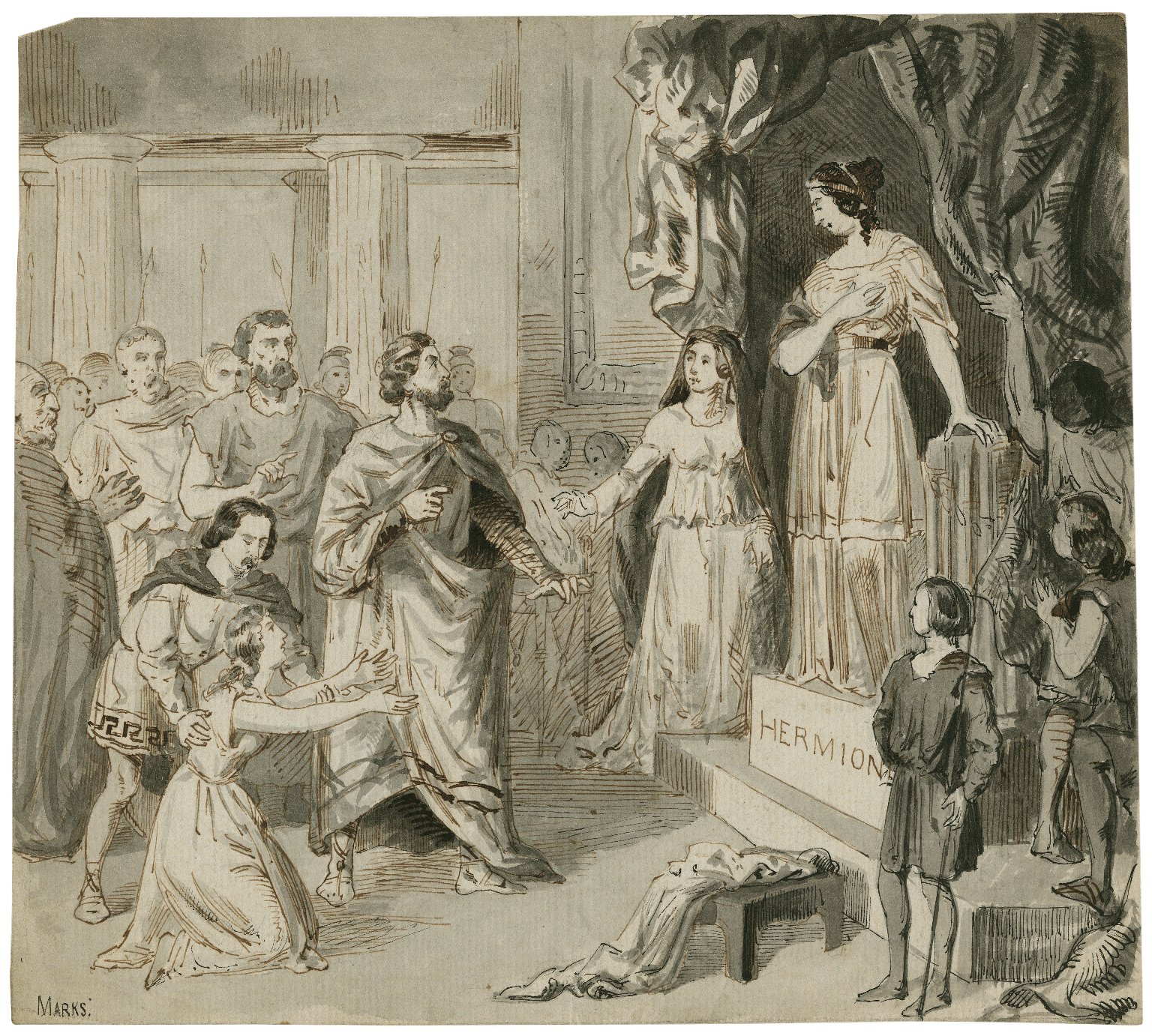 In Act V Scene II, the gentlemen speaking of the sculptor of the statue of Hermione say "had he himself eternity and could put breath into his work, would beguile Nature of her custom, so perfectly he is her ape". This high opinion of an artist, especially in light of Hermione's statue coming alive at the end of the play, reminded me of the ending of Shakespeare's Sonnet 18 when it says: "So long as men can breathe or eyes can see, So long lives this and this gives life to thee." In Hermione's case, this became quite literal since her statue (somehow) allowed her to come back to life. While the quality of the statue was not the only factor in her return to life, the incredible accuracy of the statue appears to allow Leontes to imagine that it really is his wife. This is a very bold statement about the power of art to immortalize its subject.
In Act V Scene II, the gentlemen speaking of the sculptor of the statue of Hermione say "had he himself eternity and could put breath into his work, would beguile Nature of her custom, so perfectly he is her ape". This high opinion of an artist, especially in light of Hermione's statue coming alive at the end of the play, reminded me of the ending of Shakespeare's Sonnet 18 when it says: "So long as men can breathe or eyes can see, So long lives this and this gives life to thee." In Hermione's case, this became quite literal since her statue (somehow) allowed her to come back to life. While the quality of the statue was not the only factor in her return to life, the incredible accuracy of the statue appears to allow Leontes to imagine that it really is his wife. This is a very bold statement about the power of art to immortalize its subject.
Saturday, October 3, 2015
The Eternal Nature of Art
 In Act V Scene II, the gentlemen speaking of the sculptor of the statue of Hermione say "had he himself eternity and could put breath into his work, would beguile Nature of her custom, so perfectly he is her ape". This high opinion of an artist, especially in light of Hermione's statue coming alive at the end of the play, reminded me of the ending of Shakespeare's Sonnet 18 when it says: "So long as men can breathe or eyes can see, So long lives this and this gives life to thee." In Hermione's case, this became quite literal since her statue (somehow) allowed her to come back to life. While the quality of the statue was not the only factor in her return to life, the incredible accuracy of the statue appears to allow Leontes to imagine that it really is his wife. This is a very bold statement about the power of art to immortalize its subject.
In Act V Scene II, the gentlemen speaking of the sculptor of the statue of Hermione say "had he himself eternity and could put breath into his work, would beguile Nature of her custom, so perfectly he is her ape". This high opinion of an artist, especially in light of Hermione's statue coming alive at the end of the play, reminded me of the ending of Shakespeare's Sonnet 18 when it says: "So long as men can breathe or eyes can see, So long lives this and this gives life to thee." In Hermione's case, this became quite literal since her statue (somehow) allowed her to come back to life. While the quality of the statue was not the only factor in her return to life, the incredible accuracy of the statue appears to allow Leontes to imagine that it really is his wife. This is a very bold statement about the power of art to immortalize its subject.
Subscribe to:
Post Comments (Atom)
I really like that you mentioned that. It kind of says something about Shakespeare if now, hundreds of years later the art of his writing is still beautiful and of worth. Life the art, his writing seems to be immortal. Maybe that is what marks a true artist, someone whose work can always be applicable and beautiful without limitation of time or space.
ReplyDeleteIt's true, the fact that Shakespeare has two characters actively discussing the statue and even name the artist show that he is really connecting life and vitality with art. The interesting thing is that the statue has wrinkles as well. Instead of art forever keeping someone young like in the sonnets Shakespeare seems to be expressing a more mature idea that art is in tandem with the natural flow of life. It does not try to escape it, but immortalizes the flow of the years.
ReplyDeleteThat is a really interesting (and viable) point. I wonder, which came first? This sonnet or the play? Not that it would necessarily change anything, but I'm curious... I'll have to check it out.
ReplyDeleteI thought about this a lot as well. It's definitely an interesting commentary on how art is connected to us as people, as though it has life. I wonder why instead of having her resurrected in some other way (not sure what that would be, but anyway), he chose to have art come to life to become this beautiful and admirable woman.
ReplyDelete